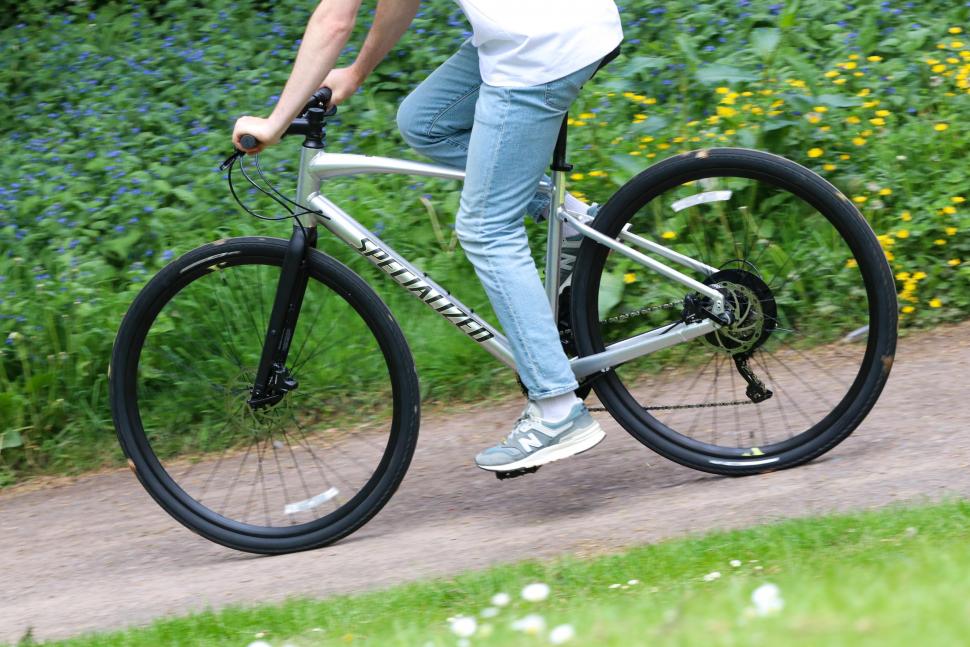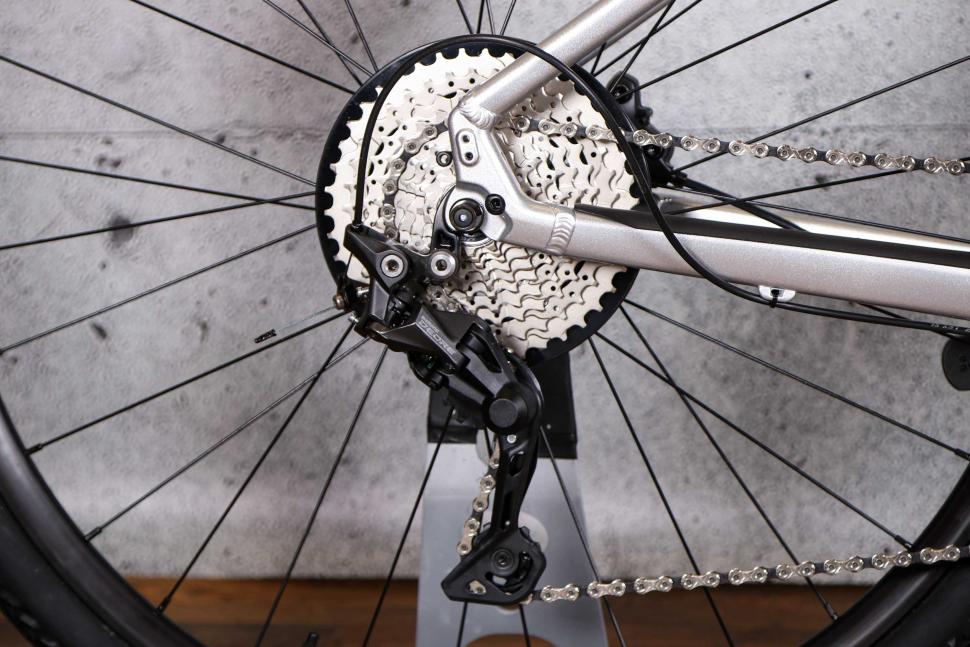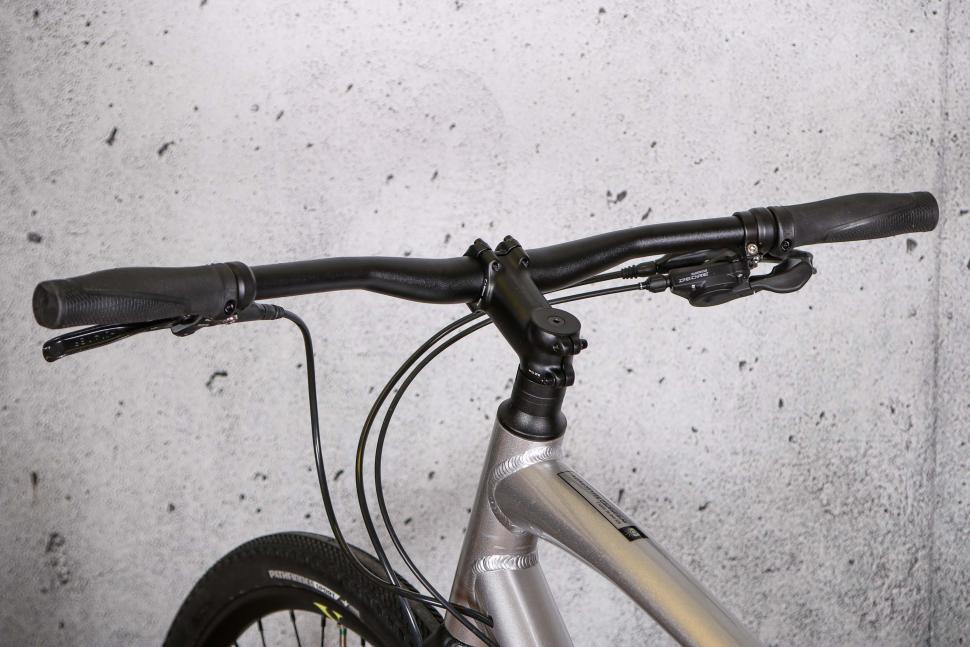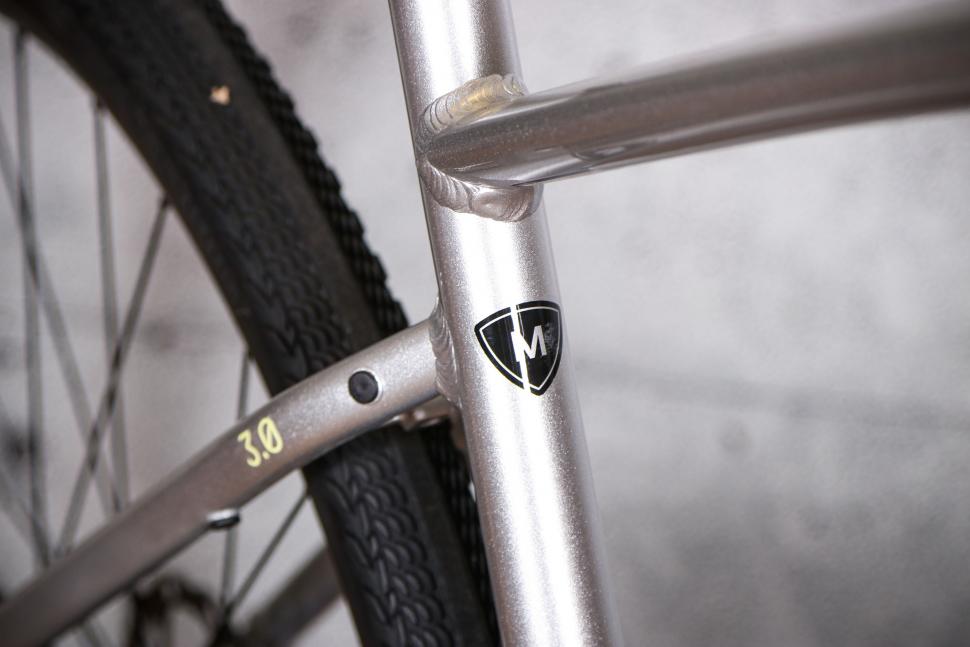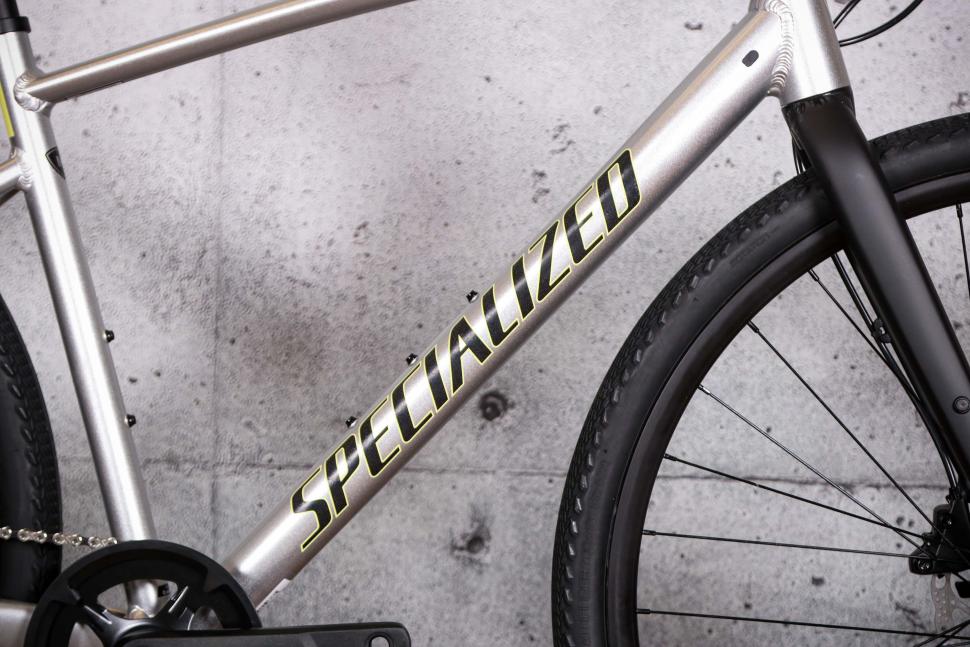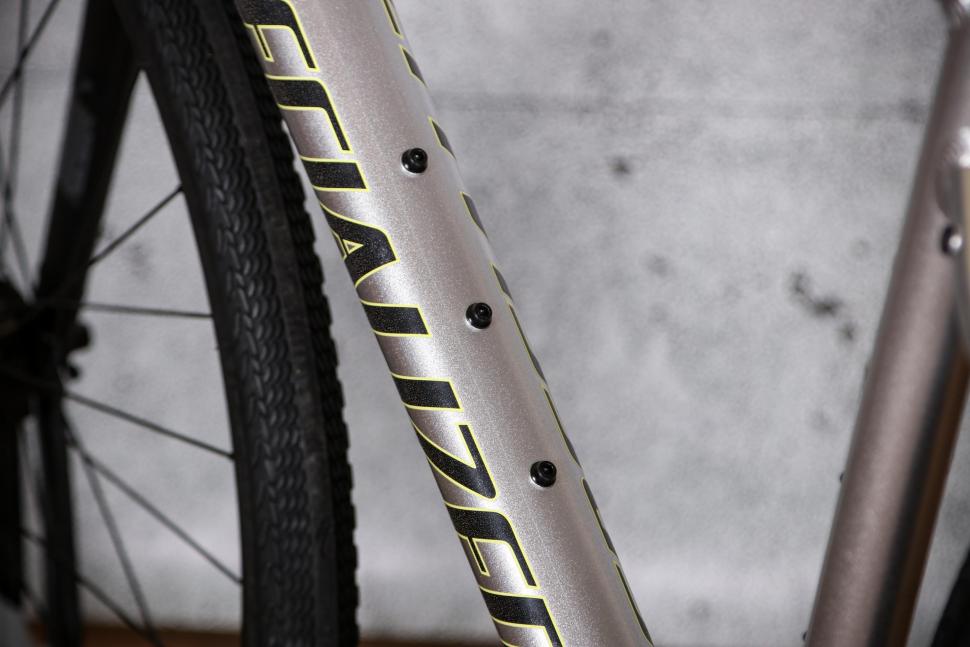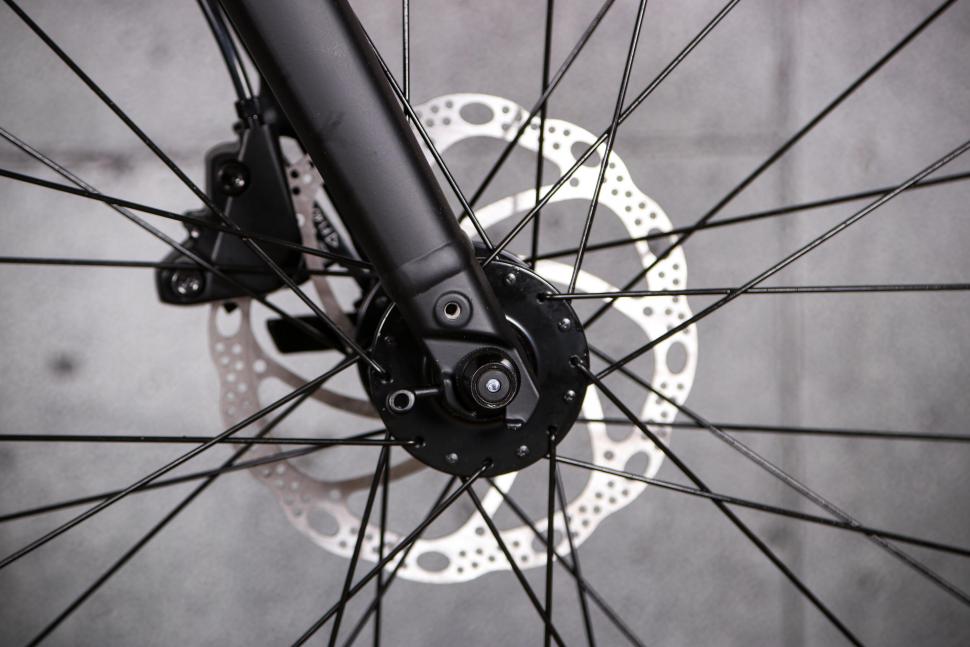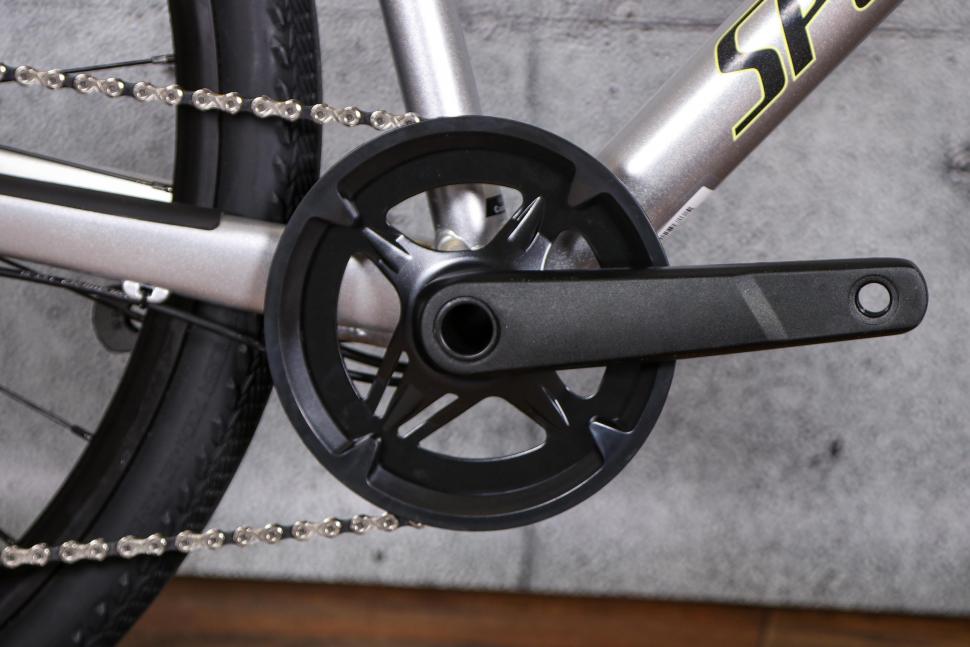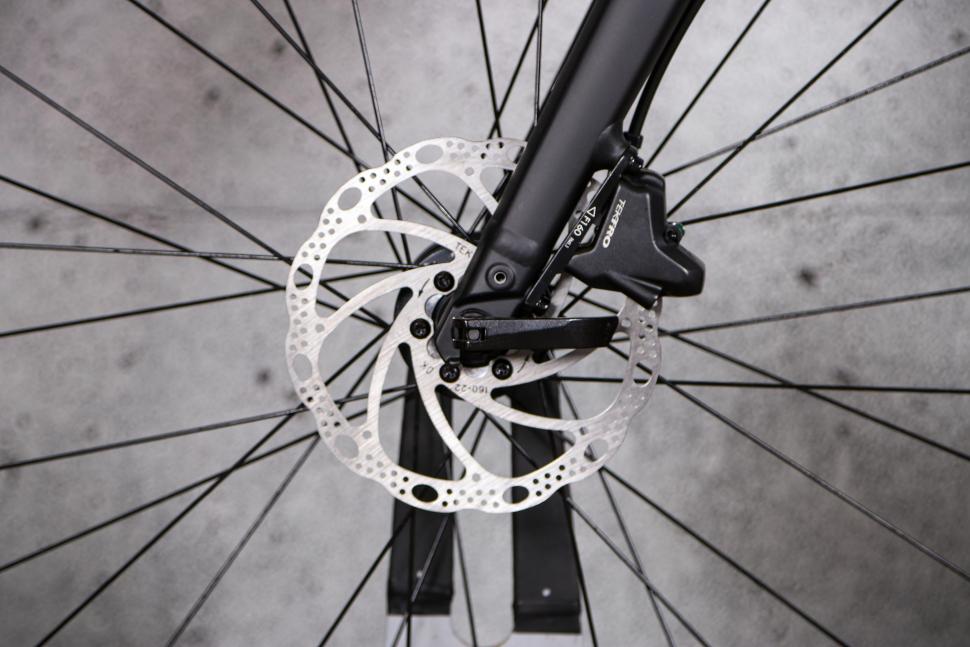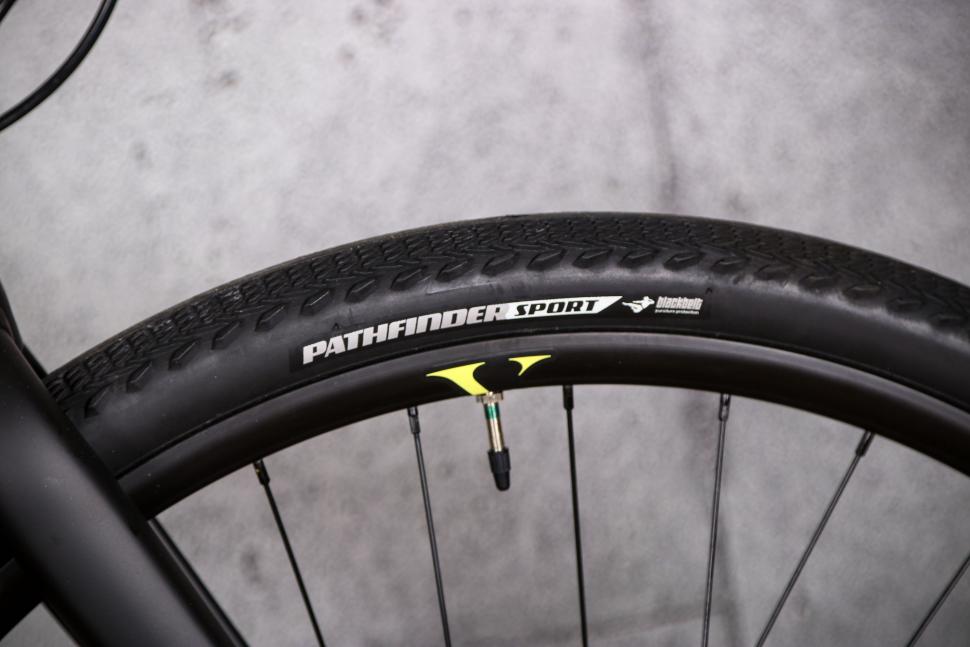The Sirrus X 3.0 is a beefed-up version of Specialized’s fitness bike, and has a bit more of a ‘do-it-all’ attitude. With wide wheels and tyres matched to a mountain bike riser bar, this bike is just as nimble on the byways as it is bombing around town or getting you to work. There’s some stiff competition out there on price, though.
The Sirrus range of bikes are hybrids, with either a compact or step-through frame, slick tyres and usually a 2x chainset. The Sirrus X models add a bit more versatility, thanks to 42mm gravel tyres, an extra-wide handlebar (in road bike terms…) for better handling off-road and a decent spread of gears from a 1x set up as well.
It’s a fun bike to ride all over the place. I’ve mostly used it on the school run or riding in the woods with the kids, and it’s a blast.
Even with the 680mm handlebar the steering is still pretty nippy, and the X 3.0 makes for a capable gravel machine. In fact, it’s probably not far off the rigid mountain bikes I was riding in the late 80s, early 90s.
It’s nowhere near as quick as my drop bar machine, but on those days when I just want to cruise along the tracks taking in the scenery with a couple of bar bags fitted, the stability of the slack front end and longish wheelbase meant I enjoyed the ride.
My longest ride was about 2.5hrs over 35 miles on a mixture of surfaces from road, byways in various states of hardpack and some grass/mud thrown in for good measure. For what is essentially an entry level aluminium alloy frame and fork, the ride quality isn’t bad, even with the tyres pumped up firm.
It copes with rough terrain well, and I never felt like I was being battered – although I found the lack of hand positions that a flat bar brings odd, something I must admit I’m not that used to.
The 40t chainring and 10-speed, 11-42t cassette gives a decent spread of gears, and is similar to a lot of 1x gravel bikes I’ve ridden. It helps offset the weight a touch, and it was only on the steepest climbs that I found the X 3.0 a bit of a strain.
On the road the Sirrus X cruises along quite well. The lower gears give you decent acceleration for nipping away from traffic lights or junctions, and the reasonably quick handling allows you to change direction with ease when the need arises. The bar width does limit the gaps you can cut through when filtering, though if you’re used to modern mountain bikes with their 760mm-780mm bars you may find it relatively narrow.
You do get a reasonably tall riding position too, which helps you see over traffic when in town.
From a riding point of view, I really like the Sirrus X. It was better in pretty much every environment than I was expecting. It doesn’t feel as weighty as the scales suggest, and the performance surprised me, even when slogging into a headwind. The main thing here is versatility, and that’s something the Specialized does very well.
Frame and fork
The Sirrus X uses Specialized’s A1 Premium Aluminium tubing, which it says is butted – the tubes have differing wall thicknesses along their length. They’re normally thicker at the ends for strength at the welds, and thinner in the middle for a bit of flex / weight loss, which can increase comfort marginally.
The welding is a touch… industrial, shall we say, but that kind of works given the bike’s nature, especially with this silver colour. It’s also available in a dark red.
A neat touch is that the Specialized logos on the down tube look black during the day, but are reflective for side visibility in the dark.
On the down tube you get three bolt positions for a bottle cage giving you some adjustment should you be running a frame bag, while the seat tube has just the standard two bolts.
Mudguard and rack mounts can also be found on the frame and fork, though if you want to go down that route the EQ models of the Sirrus X come fitted with mudguards, a rear rack (both compatible with Spesh’s Plug + Play system) and a dynamo front light.
Both the frame and that full aluminium fork have flat-mounts for the brake calipers, and quick-releases for the wheels with standard dropouts. Thru-axles are now the norm with disk brakes, but for the kind of performance and speeds achievable by the Sirrus X, the extra level of retention is not really required.
Geometry and sizing
If you are used to standard road or gravel bike geometry – and basing your frame size on top tube length – you’ll need to go up a size over normal to account for the relatively short stem. For instance, this medium has an effective top tube of 574mm, which is about 20mm longer than a typical road/gravel bike for me, but the fit is correct.
Combined it with the 80mm stem and the reach figure is 398mm, which is exactly the same as the new Allez Sprint Comp road bike in a 56cm. The stack is a fair bit higher due to the Sirrus X’s tall 180mm head tube, giving 593mm.
The front end is a mixture of a head angle is a gravel friendly 71°, with a fork length of 395mm and a rake/offset of 51mm. The wheelbase comes in at 1,067mm.
Also, alongside this frame design is a range of step-through models.
Finishing Kit
The Sirrus X 3.0 is predominately a Shimano build, and the cassette, rear mech and shifters are adorned with the Deore badge. It’s a 10-speed groupset using an 11-42t cassette matched with a 40t narrow-wide chainring on an unbranded alloy crankset.
It’s a decent spread of gears for a range of riding, although there are limitations at either end. For road use I only really used the four smallest sprockets on the flat, while on the descents you’ll soon be spinning out.
Away from the beaten track the 40/42t lowest gear does a decent job on the climbs of offsetting the weight, although when things got really steep, I was calling out for something lower. The shifting is clean enough up and down the cassette, and the lever buttons sit in just the right position. KMC supplies the chain and you also get a threaded bottom bracket for wet weather reliability.
If, like me, you are used to seeing the prices of road hydraulic disc brake setups, you’ll be amazed to see the kit you get with a flat bar. There is no way you are going to find a sub-£1,000 road bike with hydraulic brakes.
Here though you are getting Tektro’s HD-R280 hydraulic brakes with a 160mm rotor for the front and 140mm at the rear. These brakes never left me wanting even with just two fingers, and offer decent modulation too.
> road.cc Commuting Bike of the Year 2020/21
The rest of the kit is basic stuff with an alloy stem, seatpost and handlebar. The bar is 680mm wide on this medium size and offers a 15mm rise and 9° backsweep. I found the Specialized Neutralizer locking grips comfortable, especially considering the limited hand positions.
The saddle is a Bridge Sport and I found it comfortable considering the upright position. With a lot of weight on it for the majority of the ride, I found it to have a good amount of padding that wasn’t overly squishy.
Wheels and tyres
As with the rest of the finishing kit, the wheels aren’t anything exciting. You get double-wall alloy rims that are 22mm deep with a 21mm internal width, alloy hubs with loose ball bearings, 32 stainless steel spokes front and rear and those QR axles.
Durability wise I had no issues, and they did see a fair bit of abuse up on the gravel tracks. They aren’t the lightest wheels out there and don’t bring a huge amount to the ride quality, but to be honest that isn’t really what this Sirrus X is about.
The 42mm wide Pathfinder Sport tyres from Specialized are good. They roll well on the road and cope with hardpacked surfaces with ease. In fact, they work anywhere in the dry. With minimal tread they struggle to cope with anything muddy, but they are versatile. If you’re using the Sirrus X for a commute you can easily switch between road, byway or canal path without any real drop in performance.
> 19 of the best 2021 gravel bikes & adventure road bikes
Again, they aren’t the lightest with their wire bead construction, but they make up for it in robustness. Across a range of terrain, I had no problems with punctures or cuts in the carcass.
Value
This X 3.0 (there is a new version available, which I’ll explain about in a moment) is £849, which makes it a bit cheaper than the £899 Giant Escape 0 Disc that Simon tested last year. Subjectively I’d say that the Sirrus X is a better looking, beefier bike, although the Giant is over half a kilo lighter and gets a carbon fibre seatpost. Both bikes use a 1x Deore groupset.
Simon also reviewed the Merida Speeder 200 hybrid and he was impressed. It’s a bit more road-based with tyre widths limited to 35mm, that’s still wide enough for a bit of byway action. Its price has jumped up to £885 from £775 last January, but it still looks decent value with a 9-speed Shimano Sora groupset, hydraulic brakes and an FSA 50/34t chainset.
If you want something a little more off-road, you’ll want Merida’s Crossway range. The Crossway 300 is the same price as the Speeder at £885 and comes with a Deore groupset, the same as the Sirrus. It has an FSA Alfa Drive chainset though with triple rings (48-36-26T) giving 30 gears, and a Suntour NCX-D LO suspension fork with lockout. It’s also wearing 40mm tyres.
So, the Sirrus X 3.0 looks competitive in this build. The latest model has jumped in price to £949 though, and comes with a 9-speed microSHIFT TrailTrigger Pro setup. The overall gearing range is the same, at least, as is the rest of the build.
The Deore build is still available in certain sizes though, and that is the one I’d go for.
Overall
The X 3.0 kind of fills in that middle ground between a hybrid and a hardtail, and it’s decent value if you want a bike you can do a lot of things on – whether that’s commuting, riding for fitness or getting out with the kids. Its ability to take those 42mm tyres means it works well off-road too.
Verdict
Hybrid do-it-all with a bit of edge and attitude, just as happy around town as it is on the byways
If you’re thinking of buying this product using a cashback deal why not use the road.cc Top Cashback page and get some top cashback while helping to support your favourite independent cycling website
Make and model: Specialized Sirrus X 3.0
List the components used to build up the bike.
DRIVETRAIN
Chainrings
40T
Cassette
Shimano Deore, 10spd, 11-42t
Rear Derailleur
Shimano Deore M4120, SGS, 10-speed
Shift Levers
Shimano Deore M4100, 10-speed
Bottom Bracket
Threaded BSA 68mm
Crankset
Forged aluminum arms, 2-piece, 24mm spindle, Narrow-wide steel chainring
Chain
KMC X10, 10-speed w/ reusable Missing Link
COCKPIT
SeatPost
Alloy, 12mm offset, 2-bolt clamp, 27.2mm
Handlebars
Stout Mini Rise, alloy, 9-degree backsweep, 15mm rise, 31.8mm
Seat Binder
Bolt-type, 31.8mm
Stem
Specialized, 3D-forged alloy, 4-bolt, 7-degree rise
Saddle
Bridge Sport, Steel rails, 155/143mm
Tape
Specialized Neutralizer, Body Geometry, locking grip
BRAKES
Rear Brake
Tektro HD-R280, hydraulic disc, resin pads, flat-mount, 140mm
Front Brake
Tektro HD-R280, hydraulic disc, resin pads, flat-mount, 160mm
WHEELS & TIRES
Inner Tubes
Presta, 40mm valve
Rear Hub
Alloy, 6-bolt disc, 8-/9-speed freehub, loose ball bearing, quick-release, 32h
Front Hub
Alloy, 6-bolt disc, loose ball bearing, quick-release, 32h
Rims
700C disc, double-wall alloy, 22mm depth, 21mm internal width, 32h
Spokes
Stainless, 14g
Front Tire
Pathfinder Sport, 700×42
Rear Tire
Pathfinder Sport, 700×42
Tell us what the bike is for and who it’s aimed at. What do the manufacturers say about it? How does that compare to your own feelings about the bike?
Specialized says, “Sirrus X is your ticket to riding more, and to places you never imagined possible. It’s a comfortable, capable, ‘let’s do stuff’ kind of bike that will inspire you to ride more than you ever have before. With bigger, confidence inspiring tires, a slightly more upright riding position, a super intuitive one-by drivetrain, and plenty of mounts for racks and fenders – it’s more than just a solid partner on pavement. Sirrus X is a dialed option when it’s time to hit some gravel. We’ve also equipped every Sirrus X with next-level comfort from our scientifically tested and ergonomically engineered Shared Platform Body Geometry saddle, handgrips, and pedals.”
I found it one of those bikes that I could ride all over the place, from taking the kids to school to a bit of canal path touring, some light gravel and jaunts out through the country lanes.
Where does this model sit in the range? Tell us briefly about the cheaper options and the more expensive options
Below this is the Sirrus X 2.0 in both standard and step-through top tube setups. There is a X 4.0 for £1,299 which comes with an 11-speed groupset. There are also EX models in the 3.0 (Step Through) and 4.0 models which include racks and dynamo lights.
Overall rating for frame and fork
8/10
Tell us about the build quality and finish of the frame and fork?
It’s a quality frame with reflective decals.
Tell us about the materials used in the frame and fork?
Frame
Specialized A1 Premium Aluminum, Fitness Geometry, butted tubing, internal cable routing, flat-mount disc, quick-release, Plug + Play rack/fender mounts
Fork
A1 Premium Aluminum, flat-mount disc, Plug + Play fender mounts, low rider rack mounts, quick-release
Tell us about the geometry of the frame and fork?
From a road point of view it’s a pretty relaxed front end, but venture off-road and it’s a great balance of neutrality and fun.
How was the bike in terms of height and reach? How did it compare to other bikes of the same stated size?
For me the balance of stack and reach worked well; I could get out of the wind on a quicker ride, but it’s not too extreme if I was cruising around town.
Was the bike comfortable to ride? Tell us how you felt about the ride quality.
Yes, comfort was very good. The saddle is comfortable for an upright position and the wide handlebar allows plenty of arm positions. Ride quality from the frame is decent for what is essentially an entry-level aluminium alloy frame and fork.
Did the bike feel stiff in the right places? Did any part of the bike feel too stiff or too flexible?
For the type of riding intended, I’d say the Sirrus has plenty of stiffness.
How did the bike transfer power? Did it feel efficient?
Overall, yes. The 1x groupset gives a large spread of gears allowing you to accelerate quickly from a standing start.
Was there any toe-clip overlap with the front wheel? If so was it a problem?
No.
How would you describe the steering? Was it lively neutral or unresponsive? On the road very neutral, while fun off-road.
Tell us some more about the handling. How did the bike feel overall? Did it do particular things well or badly?
The Sirrus is designed as a bit of a jack of all trades, and it achieves that. The handling is slowed a touch in urban areas due to the wide handlebar, but it feels composed when going quick on looser surfaces.
Which components had the most effect (good or bad) on the bike’s comfort? would you recommend any changes?
The saddle is supportive and comfortable for the upright position.
Which components had the most effect (good or bad) on the bike’s stiffness? would you recommend any changes?
There was no feeling of flex from any of the components.
Which components had the most effect (good or bad) on the bike’s efficiency? would you recommend any changes?
I don’t think I’d be in a hurry to change anything to be honest. For the money it all works really well.
Rate the bike for efficiency of power transfer:
8/10
Rate the bike for acceleration:
7/10
Rate the bike for sprinting:
6/10
Rate the bike for high speed stability:
7/10
Rate the bike for cruising speed stability:
8/10
Rate the bike for low speed stability:
8/10
Rate the bike for flat cornering:
8/10
Rate the bike for cornering on descents:
8/10
Rate the bike for climbing:
7/10
Rate the drivetrain for performance:
8/10
Rate the drivetrain for durability:
8/10
Rate the drivetrain for weight:
7/10
Rate the drivetrain for value:
5/10
Tell us some more about the drivetrain. Anything you particularly did or didn’t like? Any components which didn’t work well together?
The drivetrain works really well. The shifts are crisp and I never had a fluffed one. The Tektro brakes are great for the type of riding you are likely to do with this, and highlight the value that can be achieved from flat bar set ups over drop bar offerings.
Rate the wheels for performance:
7/10
Rate the wheels for durability:
8/10
Rate the wheels for weight:
7/10
Rate the wheels for comfort:
7/10
Rate the wheels for value:
5/10
Tell us some more about the wheels.Did they work well in the conditions you encountered? Would you change the wheels? If so what for?
It’s a decent set of wheels that I had no issue with either on or off-road.
Rate the tyres for performance:
8/10
Rate the tyres for durability:
8/10
Rate the tyres for weight:
7/10
Rate the tyres for comfort:
7/10
Rate the tyres for value:
5/10
Tell us some more about the tyres. Did they work well in the conditions you encountered? Would you change the tyres? If so what for?
Roll well on the road, and are capable enough on hard-packed terrain like canal paths.
Rate the controls for performance:
7/10
Rate the controls for durability:
8/10
Rate the controls for weight:
7/10
Rate the controls for comfort:
7/10
Rate the controls for value:
5/10
Tell us some more about the controls. Any particularly good or bad components? How would the controls work for larger or smaller riders?
The wide bar slows the steering a bit for urban use, but is a welcome addition when off-road. The saddle does a good job of reducing pressure even when riding in an upright position.
Did you enjoy riding the bike? Yes
Would you consider buying the bike? Yes, this makes a great ‘daily’ bike for all of those various jobs
Would you recommend the bike to a friend? Yes
How does the price compare to that of similar bikes in the market, including ones recently tested on road.cc?
It’s a bit cheaper than the Merida options and the Giant mentioned in the review, but it doesn’t quite match the spec list of any of them. Things look even less competitive on the new microSHIFT option.
Rate the bike overall for performance:
7/10
Rate the bike overall for value:
5/10
Age: 42
I usually ride: This month’s test bike My best bike is: B’Twin Ultra CF draped in the latest bling test components
I’ve been riding for: Over 20 years I ride: Every day I would class myself as: Expert
I regularly do the following types of riding: time trialling, commuting, club rides, sportives, fixed/singlespeed,

